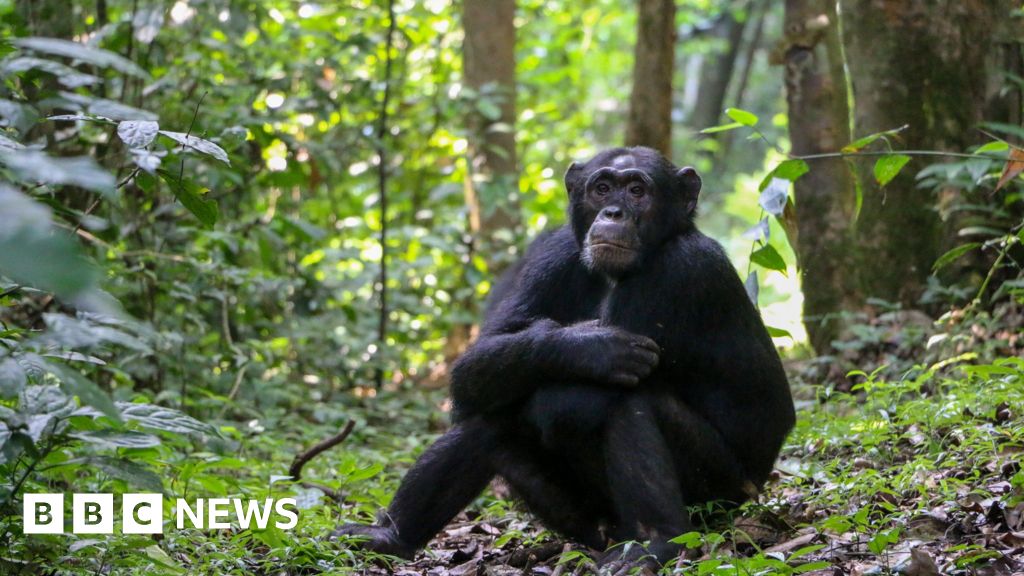Chimpanzees have been observed using a wide range of plants for medicinal purposes. A study conducted in Uganda’s Budongo Forest, published in PLOS ONE, has insights into the self-medicating practices of wild chimpanzees.

Also Read: Elephants Use Unique Names to Call Each Other, Study Reveals
Researchers spent eight months observing 51 chimpanzees across two communities in Budongo Forest, Uganda.
Focus was on identifying plants consumed by chimps when they showed signs of illness or injury. A total of 17 samples from 13 different plant species were collected and analyzed for medicinal properties.
The research team followed sick chimpanzees for 10 hours a day, noting their plant consumption habits.
Observations included signs of illness such as abnormal urine, diarrhea, visible wounds and behavioral changes indicating discomfort.
Emphasis was placed on whether chimps sought out plants not part of their regular diet hinting at medicinal use.
Chimpanzees were seen eating parts of various plants including leaves, bark and wood, many of which were not typically part of their diet.
Most plants consumed by sick chimps showed antibacterial and anti-inflammatory activities when tested in vitro.
Eleven of the 13 plants had documented use in local traditional medicines, supporting the idea that chimps might use plants for their healing properties.
All observed chimps recovered from their ailments relatively quickly though researchers cannot conclusively attribute recovery solely to plant consumption. This suggests a link between plant consumption and health benefits.
While other animals such as dolphins and orangutans have been seen using natural substances for medicinal purposes, chimpanzees display a diverse range of self-medicating behaviors.
For example, dolphins rub against corals and sponges to treat skin infections and orangutans have been observed using plant-based pastes to treat wounds.
The primary goal of the study was to determine whether wild chimpanzees intentionally consume plants with medicinal properties to treat specific ailments or if they simply consume these plants by chance.
Researchers from the University of Oxford and Neubrandenburg University of Applied Sciences collaborated to explore this question through a combination of behavioral and pharmacological analyses.
Also Read: Harvard Scientists Say Aliens May be Living Among us in Disguise
The study was conducted in the Budongo Central Forest Reserve in Uganda, focusing on 51 chimpanzees from two different communities that are habituated to human presence.
This location was chosen due to its rich biodiversity and the presence of variety of plant species known for their medicinal properties.
Researchers observed the chimpanzees’ behavior, noting instances where sick or injured individuals consumed specific plants not typically part of their regular diet.
The behaviors of chimpanzees with visible wounds or signs of illness such as gut infections, were closely monitored to identify any deviations in their dietary habits.
The research team collected plant samples from 13 different species of trees and herbs suspected to have medicinal properties based on the chimpanzees’ consumption patterns.
These samples were then subjected to pharmacological testing to determine their anti-inflammatory and antimicrobial properties.
The study revealed that 88% of the plant extracts inhibited bacterial growth, indicating strong antimicrobial properties.
Additionally, 33% of the extracts demonstrated anti-inflammatory effects, suggesting their potential use in treating conditions associated with inflammation.
Medicinal Plants Identified:
Alstonia Boonei: This tree, a member of the Dogbane family exhibited the strongest antibacterial activity among the tested plants. It also demonstrated anti-inflammatory properties. Alstonia boonei is traditionally used in East African communities to treat bacterial infections, gastrointestinal issues and snake bites.
Khaya Anthotheca: The bark and resin from this East African mahogany tree showed potent anti-inflammatory effects. It is likely that the consumption of this plant helps reduce pain and swelling.
Christella Parasitica: Leaves from this fern were found to have anti-inflammatory properties. A male chimpanzee with an injured hand was observed seeking out and consuming these leaves possibly to alleviate pain and reduce swelling.
Scutia Myrtina: The bark of the cat-thorn tree, which had not been previously observed in the chimpanzees’ diet, was consumed by an individual suffering from a parasitic infection. Testing revealed that the bark possessed both antimicrobial and anti-inflammatory properties.
Also Read: Water Frost Detected on Mars’s Tharsis Volcanoes





















